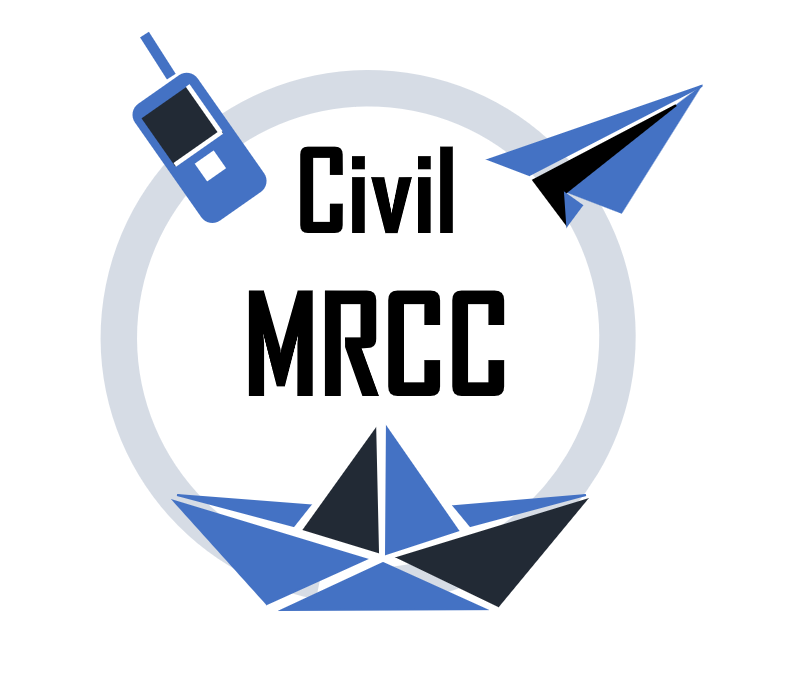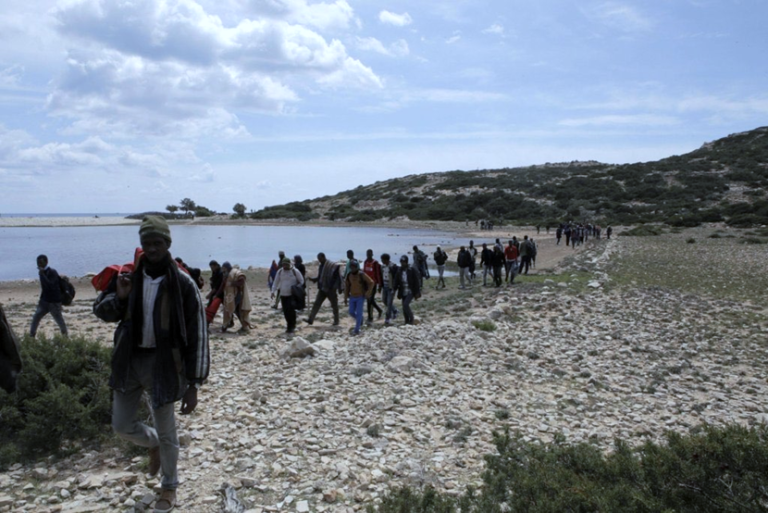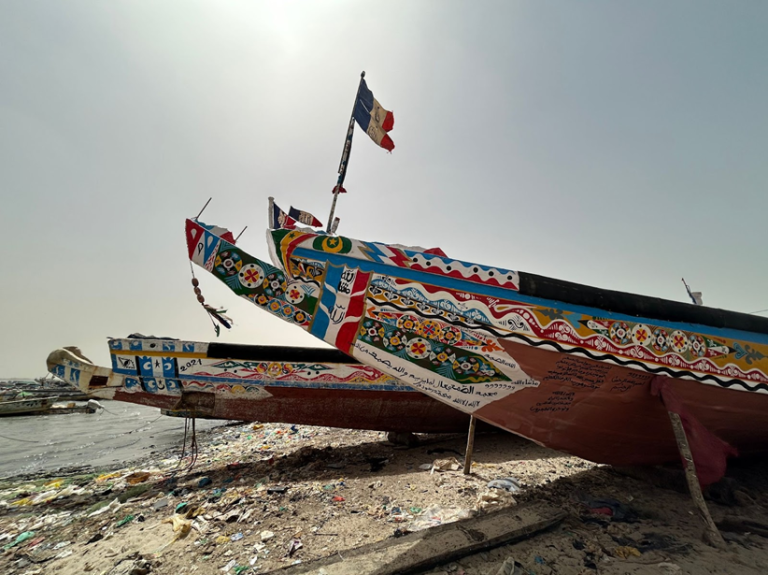In our struggles against borders, we are often confronted with difficult questions around media representations of the violence we witness. We are witnesses of atrocious violence experienced by people on the move. We witness people’s deaths, people’s desperation, people’s calls for help. And we, as SAR structures and no-border groups, are often the only critical gaze on this violence.
The violence we witness is often made invisible by authorities, who try to deceive their role in orchestrating it. It is therefore our responsibility to make it visible, as to denounce not only the border regimes, but also the dynamics under which these abuses are taking place. It is our responsibility to make visible that violence and death at the border are not accidental but systemic, that violence is endemic to borders rather than their unintended consequence. It is our responsibility to point fingers not towards allegedly dangerous traffickers who put people in danger, but towards authorities that create, design and implement borders and their militarisation. It is also our responsibility to demonstrate that if there were no borders there would be no death and violence. In grappling with this responsibility, we are always trying to develop our collective analysis and practices through self-critique and self-reflection. It is trial and error, and a collective process we are constantly engaged in.
With this responsibility, indeed, several questions and dilemma emerge:
- How to represent violence experienced by people: what are the consequences of these representations? And how they might contribute to people’s essentialisation merely as ‘vulnerable’ or ‘suffering’ subjects, and somehow to their dehumanisation?
- How to avoid the paternalistic over-victimisation of the people we encounter in our struggle against borders, but also how to avoid over-romanticisation of their ‘agency’?
- How do we mobilise ‘outrage’ about border violence, while avoiding the spectacularization of people’s suffering, the exposure of their bodies and again a narration that reduces them to the single experience of being ‘objects’ of violence?
- How to politicise this outrage, whilst at the same time avoiding turning it into an exercise of ‘training’ white eyes to violence? How to avoid placing mostly white, mostly European voices, emotions, and our life-saving heroic actions at the centre of the narration of this struggle?
- How do we denounce externalisation deals, but also overcome the civilising language that portrays non-EU actors or (to a lesser extent) Southern and Eastern European actors, civil societies and institutions as primitive, corrupt, criminal human right violators, etc, while Europe, and Central and Northern Europe in particular, is described as ‘safe’, ‘lawful’ and human-rights oriented?
- How do we take care of each other and of the people we encounter, without centering ourselves and our feelings or avoiding paternalistic approaches?
These questions are not new to any of us, nor are they new historically. People in the struggle for Black liberation have been interrogating themselves on similar questions in their fight against the oppression of Black people in the USA, as well as in the struggle for the abolition of slavery. Whilst, as we know, slavery and migration should not be conflated, as to avoid reducing the migration experience and subjectivity to one of enslaved subjects without agency, we have much to learn from these struggles for liberation and abolition. They teach us how to centre struggles and resistance of those enslaved, imprisoned and oppressed. Many of us are indeed inspired by the underground railroads in our organising structures for the abolition of borders.
Black feminist Sadiya Hartman, in her book ‘Scenes of subjection’ (1997), powerfully interrogates the role of images, language and narratives, and brings to the front many of the questions raised above. How great would it be to see this text included in the standard ‘SAR training programs’ followed by activists and volunteers on board of rescue ships, or for anyone organising media work for our structures, as well as legal and advocacy work.
The colonial gaze
Sadiya Hartman, in her accounts of slavery, refuses to engage with imaginaries of violence and torture as they reinforce ‘the spectacular character of Black suffering’. What is the boundary, she asks, between becoming a witness of horror and becoming a ‘voyeur’ and spectator? According to her, these images are not useful in inciting indignation. On the contrary, ‘they immune us to pain by virtue of their familiarity’. How can we communicate the violence without letting the reader stop to a merely compassionate movement? How can we politicise these sentiments and create a more complex analysis of the context from which the violence is coming from?
Black Feminist Christina Sharpe, in her book ‘In The Wake’ resonates with Hartman’s arguments, how the reproduction of violence inflicted on black bodies is not a weapon against white supremacy – as on the contrary it keeps reproducing imaginaries of Black and brown bodies as subject of violence, victimisation and dehumanisation.
Rescued people, indeed, often become sacred victims, completely de-historicised. Through a narrative centered on the rescue, NGOs risk sanctifying the existence of the people whose past is oblivion. More interestingly, the people’s future is also very uncertain. To an EU-white gaze, people start existing in the moment of distress and rescue. They start existing in the moment ‘we’ (very often the -white – narrating voice) ‘see’ them, and ‘save’ them’. Being in danger and needing help is constitutive of our construction of the migrant experience. Our narratives bring migrants into life in the moment they need to be ‘saved’, but there is no historicization of their journey, of their trajectories, of their existence before and after rescue. Violence and violation of one’s body and existence are the first moment people appear and start to exist in European world-views, imaginaries and narratives. From this point of view, their existence not only depends on the ‘rescuer’ but ‘originates from the rescue.
In this perspective, the reasons why they have to be rescued are forgotten, the responsibilities for such endangerment disappear. Neo-colonial relations between Europe and the countries of the Global South are veiled, and rescue becomes the apex moment of a routinised, dehumanised encounter. What happens “before” is in many cases idealised and essentialised, through images of supposedly undefined “hells”.
If, however, there are not so many qualms, on the part of many NGOs, in denouncing in a generalist manner ‘the Libyan horrors’ or ‘Tunisian racism’, there does not seem to be an equally careful analysis of the racist, discriminatory and exclusionary regime of the Italian and European reception system, for example, or more generally of the progressive steps towards the hollowing out from within of the right to asylum in Europe. Thus, communications from various NGOs read: ‘We have torn them away from the Libyan horrors. Welcome finally to Italy, where you will be safe, and your rights will be respected’.
Libya and Tunisia, without distinction between governmental actors, militias and civil society, become a metaphor for abhorrent and inhuman evil, apparently lose any connection with those supposedly very human, European actors who have sanctioned neocolonial agreements with those states to externalise borders. If attempts to control migration and stop departures pass through profitable agreements with the elites of third countries and attempt to reduce them to watchdogs on Europe’s borders, the protests of civil societies are strong and documented. However, very often this is not taken into account or visibilized, strengthening colonial narratives of ‘savage’, ‘uncivilised’ or ‘primitive’ countries where illegality and corruption reigns, as opposed to a ‘safe’ and ‘civilised’ and humanitarian Europe.
In Hartman’s analyses, the circulation of these imaginaries makes it impossible to imagine the relationships between Black and white outside of these channels and paradigms. Whilst often these imaginaries are circulated in the name of the fight against racism, they can constitute one of the pillars on which racist narratives and worldviews are built. This way even border abolitionists can become complicit in reinforcing conceptions of abject ‘otherness’ while trying to challenge it.
In Europe, with a few exceptions of collaborations between self-organised migrant groups (i.e. Refugees in Libya, Boza FII, Alarm Phone network), migrants’ experiences and voices are often only heard when gathered and reproduced by NGOs or by international organisations. This way, their words are systematically reduced to ‘testimonies of violence’ rather than political claims and analyses. A key question, therefore, is how to center migrants, activists and solidarity voices, analysis and slogans from the Global South, without reducing them to cries for help? How can we amplify the voices of anger and grief and call for justice of those crossing borders without replacing them?

Alarm Phone – Commemoration organized by Alarm Phone and Boza Fii in Dakar, Senegal. October 11, 2024
Indignation, self-celebration and commodification
As SAR actors, we experience first hand how borders harm the people who try to defy them. We might see people being killed, injured, arrested, separated from their loved ones, maintained in illegality for years. And we are definitely affected. But even if some of us might feel empathy, indignation, anger, or even burn out, the lives of those of us with passport-privilege return to their ‘normality’ as soon as they decide to take distance or disengage.
A militant practice of caring for one another within our structures needs to bring to the table what it means to expose oneself to the violence experienced in witnessing it. At the same time, we must be careful not to make the mistake of centring this topic at the public level. In fact, this risks placing the focus mostly on the traumatised rescuer-hero, allowing to forget once more the structural dynamics in which the violence takes place and on those who have experienced the violence themselves.
In many cases, the latter – unlike the rescuers – have to expose themselves to the risk of the violence and do not have access to the support structures and networks to which rescuers have access instead (although, let’s face it, it is often too limited as well). In this process, eventually, the pain of those harmed is amplified and spectacularized, but never attended to. Little is said or done to repair or transform the harm experienced, or to subvert the constellations of violent regimes that have made people disproportionately vulnerable to state-sponsored exploitation, abuse, or premature death in the first place.
In the poem ‘The White Man’s Burden’ (1899) Rudyard Kipling argues that the task of the white man is to give “green light for colonialism and at the same time put the other non-white only in the weak rank that needs protection and needs to be led to light.”. We self-celebrate ourselves for ‘saving’ people from the black hole of the Mediterranean Sea, of African brutal regimes and from immense suffering. We celebrate our life-saving missions for bringing them to enlightened Europe, bringing them to life again or restoring their lost humanity.
Indignation and self-celebration allow people to take distance from an understanding of the roots of the problem of border violence, of the colonial and neocolonial structures reinforcing racism and borders, and of the responsibility we have in reproducing them even though we try to dismantle them.
Pain and suffering is often displayed to mobilise indignation to raise funds for our organisations, rather than a tool to incite mobilisation. Whilst we do need money to mobilise against borders, if this money is the value extracted from the spectacularization of suffering we risk turning people’s bodies and pain into merchandise. Indignant spectators take action by donating money, they feel they have done something to resolve their discomfort, and delegate to us the fight against borders. We, in turn, support our morally upright way of life, create jobs for ourselves, undertake NGO or academic careers specialising on this topic, finance meetings, travel costs, hotels and media campaigns that centre our voices and experiences. Besides, our friends and relatives praise us for our life-saving work.
In other words, we profit, both materially and symbolically from border violence, even when we argue that we are here to end it. This is a well known critique of humanitarianism and of the humanitarian business when white European organisations intervene in the Global South. However, it is not often reflected upon in the context of struggles against the EU border regime. The question is, how do we want to keep participating in this, and how can our struggle against borders contribute to dismantling our own SAR structures? How do we go beyond legitimising our work as necessary, and instead organise to make our work useless? If we take this question seriously, any act of legitimation of our means should be weighed and considered as a legitimation of the structures that make this work necessary.
A politics of refusal and fugitivity
After drafting the words above, we run into a very important article by Annika Lindberg, which resonates with much of what we argued above. Annika’s article reminds us that European interlocking structures of violence and dehumanisation are colonially rooted and racist, and as such “should not be considered an aberration but systemic and foundational to the European border regime” and it is inflicted at a physical, existential, as well as epistemological level (the latter referring to how we know and how we make sense of the world through narratives, categories and imaginaries). She focuses on the practices of academic research into border violence, questioning to what extent visibilisation of border harm reproduces rather than erases this violence.
In Annika Lindberg’s analysis, one of the key legitimization for making border violence visible is the need to counter-act EU authorities’ attempts to invisiblise harm, obscure their responsibility, or portray it as exceptional, as well as the need to make authorities accountable for the violence they exercise. This, following also Kotef’s work on Palestine, overlooks how the spectacle of violence is actually welcome and necessary, in most contexts, to justify border controls. Whilst at times useful, rather than indignation it produces consent by the largest sections of society, and keeps reproducing the understanding that they might be exceptional or unintended consequences of border regimes rather than intended, deliberate and central tools for their operation.
The reconstruction of the June 2022 Melilla massacre produced by El Pais and Lighthouse report can be a relevant example here. When watching it in Lampedusa, during a CommemorAction event, we could not avoid questioning to what extent these imaginaries of border deaths are reinforcing borders rather than challenging them, spectacularising and somehow participating in visiblising the somehow lethal powers of border authorities, objectifying and dehumanising those who are subjected to this absolute violence, as well as serving governments’ interests in producing fear amongst potential border crossers.
Drawing on Tuck and Yang work, Annika concludes the article by inviting researchers and activists to engage in a politics of refusal to produce knowledge that reproduces oppression, and to make way for prefigurative imaginaries that subvert imposed categories of dehumanisation and oppression.
We cannot, after all, use the masters’ tools to dismantle the master’s house, as bell hooks has taught us. Rather than engaging in politics of reaction, reproduction and representation, we should then engage in politics of refusal and fugitivity. A refusal to speak a language that represses and kills, a refusal to portray and narrate our brothers and sisters as oppressed victims, a refusal to play the politics of categorisation and dehumanisation. A refusal that will then open space for new escape routes to build a different world, imaginaries and social relationships that prefigure love, care for one another and liberation from borders, states, prisons and all the violence they are rooted on.
Deanna Dadusc & Jasmine Iozzelli



